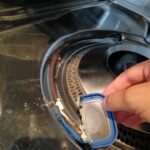To transfer propane from a small tank to a big tank, you can use a propane transfer kit or converter with a hose. This allows you to move liquid propane from one cylinder to another.
If you need to move propane from a small tank to a larger one, there are a few options available. One popular method is to use a propane transfer kit or converter, which includes a hose that allows you to move liquid propane from one cylinder to another.
This can be useful if you have a small tank that is running low and want to refill a larger tank, or if you need to consolidate propane from several smaller tanks into one larger tank. We’ll explore some of the different ways to transfer propane between tanks, as well as some safety tips to keep in mind when handling propane.
Introduction To Propane Tank Upsizing
When it comes to propane tanks, sometimes a small tank just doesn’t cut it. Whether you need more fuel for your outdoor grill, RV, or home heating system, upsizing to a larger propane tank can provide the solution. In this guide, we will explore the process of transferring propane from a small tank to a big tank, the benefits of upsizing your propane tank, and common uses for larger propane tanks.
Benefits Of Upsizing Your Propane Tank
Upsizing your propane tank comes with several key benefits:
- Extended Run Time: A larger propane tank can provide a longer supply of fuel, reducing the frequency of refills.
- Cost Savings: Buying propane in bulk often results in lower per-gallon prices, helping you save money in the long run.
- Convenience: With a larger tank, you won’t have to worry about running out of propane at inconvenient times, such as during a barbecue or in the middle of winter.
- Increased Property Value: For homes, having a larger propane tank can enhance the property’s value, especially in areas where propane is the primary heating source.
Common Uses For Larger Propane Tanks
Larger propane tanks are commonly used for various purposes, including:
- Residential Heating: Many homes in rural areas rely on propane for heating, and a larger tank ensures a steady supply during the colder months.
- Commercial and Industrial Applications: Businesses often use propane for heating, cooking, and running machinery, requiring larger tanks to meet their higher demand.
- Agricultural Operations: Farms and agricultural facilities utilize propane for heating, powering equipment, and running irrigation systems, often necessitating larger tanks for sufficient fuel storage.
- Recreational Vehicles: RVs and campers equipped with propane-powered appliances benefit from larger tanks to fuel their extended trips without frequent refills.
- Outdoor Cooking and Grilling: Propane grills and outdoor kitchens can benefit from larger tanks to ensure uninterrupted cooking sessions, especially during gatherings and events.
Pre-transfer Preparations
Prepare for transferring propane from a small tank to a big one by ensuring both tanks are in good condition and compatible for the transfer. Gather the necessary equipment and carefully follow safety guidelines to prevent accidents. Keep the area well-ventilated and avoid any potential sources of ignition during the transfer process.
Safety Equipment And Procedures
Before transferring propane from a small tank to a big tank, it’s crucial to prioritize safety. Ensure that you have the necessary safety equipment, including protective gloves, safety goggles, and a well-ventilated workspace. It’s also essential to follow proper procedures to prevent accidents and ensure a smooth transfer process.
Understanding Tank Sizes And Compatibility
Understanding the sizes and compatibility of the tanks is vital. Ensure that the big tank is suitable for receiving propane from the small tank. Check the valve and connection types to ensure they are compatible. Additionally, be aware of the maximum fill level of the big tank to prevent overfilling.
Tools Required For Propane Transfer
To transfer propane from a small tank to a big tank, you will need a propane transfer kit, which includes a propane tank adapter, valves, and a transfer line. Make sure to follow safety precautions and handle the propane cylinders with care during the transfer process.
Selecting The Right Propane Transfer Kit
When it comes to transferring propane from a small tank to a big tank, having the right tools is essential. One of the most important tools you’ll need is a propane transfer kit. This kit typically includes a transfer hose, a regulator, and various connectors. It is crucial to select the right transfer kit that suits your needs. Consider factors such as the size of the tanks you’ll be working with, the flow rate required for the transfer, and any specific safety features you may need.
Alternative Tools And Their Uses
While a propane transfer kit is the most common and convenient tool for transferring propane, there are alternative tools that can be used as well. These tools can come in handy in situations where a transfer kit is not available or not suitable for the task at hand.
One alternative tool that can be used is a converter and hose. This allows you to transfer gas from one bottle to another without the need for a specific transfer kit. However, it’s important to ensure that the converter and hose are compatible with propane and can handle the pressure involved in the transfer.
Another option is using a hand pump or siphon. This method requires manually pumping or siphoning the propane from one tank to another. While it may be time-consuming and physically demanding, it can be effective for smaller transfers or in emergency situations.
Additionally, there are specialized tools available for specific transfer scenarios, such as propane transfer pumps for larger-scale transfers or transfer adapters for specific tank connections.
It’s important to note that when using alternative tools, extra caution should be taken to ensure safety. Always follow proper safety procedures, such as wearing protective gear and working in a well-ventilated area.
In conclusion, selecting the right propane transfer kit is crucial for a successful and safe propane transfer. However, alternative tools can also be used in certain situations. Consider your specific needs and the safety requirements before choosing the appropriate tool for your propane transfer task.

Credit: www.amazon.com
Setting Up For Propane Transfer
Before you can transfer propane from a small tank to a big tank, you need to set up the necessary equipment and create a temperature gradient. Follow these steps to ensure a successful propane transfer:
Connecting The Tanks
To begin the propane transfer process, you’ll need a propane transfer kit, which typically includes a hose and adapter. Connect one end of the hose to the valve on the small tank and the other end to the valve on the big tank. Make sure the connections are secure and tight to prevent any leaks.
Creating A Temperature Gradient
To facilitate the transfer of propane, you’ll need to create a temperature gradient between the two tanks. This can be achieved by placing the small tank in a warm location, such as under direct sunlight, and the big tank in a cool area, such as in the shade or indoors. The temperature difference will cause the propane to flow from the small tank to the big tank.
It’s important to note that you should never keep a filled propane cylinder inside a hot vehicle during transportation. Always transport the cylinder in a secure, upright position to prevent any accidents or leaks. Additionally, make sure to close the cylinder valve before transportation and place the cylinder in a well-ventilated area of the vehicle.
By following these steps and taking the necessary precautions, you can safely and effectively transfer propane from a small tank to a big tank. Remember to always prioritize safety and consult the manufacturer’s instructions for any specific guidelines regarding propane transfer.
Executing The Transfer
To transfer propane from a small tank to a big tank, you will need a propane transfer kit. Attach the kit to both tanks and turn on the valves. Be sure to monitor the process and avoid overfilling the small tank.
Safety measures should be followed during the transfer process to prevent any accidents.
Step-by-step Transfer Process
To execute the propane transfer from a small tank to a big tank, you will need a propane transfer kit, which can be purchased online or from a hardware store. The kit includes a transfer hose and a regulator that connects to the small tank. Follow these simple steps to transfer propane:
- Turn off all appliances and make sure there is no open flame or spark near the tanks.
- Connect the regulator to the small tank valve and tighten it securely.
- Connect the other end of the transfer hose to the regulator outlet.
- Connect the other end of the transfer hose to the big tank valve and tighten it securely.
- Open the valves on both tanks and wait for the propane to transfer. The transfer can take up to several minutes depending on the size of the tanks.
- Once the transfer is complete, close the valves on both tanks and disconnect the transfer hose.
Monitoring The Transfer
During the transfer process, it is important to monitor the tanks to ensure that everything is working correctly and safely. Here are some tips to help you monitor the transfer:
- Make sure the tanks are stable and secure throughout the transfer process.
- Check the regulator and hose for any signs of damage or leaks before starting the transfer.
- Keep an eye on the level of propane in the big tank to ensure that it does not overfill. Overfilling can cause safety hazards and damage to the tank.
- If you notice any issues or irregularities during the transfer, stop the process immediately and seek professional assistance.
Remember to always follow safety guidelines and instructions when transferring propane. With the right equipment and careful monitoring, you can successfully transfer propane from a small tank to a big tank.
Safety Tips During Transfer
To transfer propane from a small tank to a big tank, it is important to follow safety tips to prevent any accidents. Always transport the tanks in a secure, upright position and never keep a filled propane cylinder inside a hot vehicle.
Make sure to use a converter and a hose when transferring the propane and to only move liquid instead of gas.
Avoiding Overfilling Risks
Transferring propane from a small tank to a big one can be a tricky process, and it’s important to take safety precautions to avoid overfilling risks. Overfilling can cause leaks and even explosions, which is why it’s crucial to keep an eye on the propane levels throughout the transfer process. One way to do this is by using a propane level gauge, which attaches to the tank and lets you know when it’s full.
Proper Valve Handling
Valves play a critical role in propane transfer, and it’s essential to handle them properly. Before starting the transfer process, make sure that all the valves are in the off position. Then, connect the transfer line to both tanks and open the valves slowly. It’s important to keep a close eye on the pressure gauge to ensure that the propane is flowing correctly. Once the transfer is complete, turn off the valves and disconnect the transfer line.
When transferring propane, there are a few key safety tips to keep in mind. First, make sure that both tanks are in a stable and secure position before starting the transfer process. Second, never smoke or light a flame near the tanks while transferring propane. Third, avoid overfilling the tanks by keeping a close eye on the propane levels and using a propane level gauge if possible. Finally, always wear protective gloves and eyewear to prevent injury in case of a leak or spill.
In conclusion, transferring propane from a small tank to a big one requires careful attention to safety. By following these tips, you can ensure that the transfer process is completed safely and efficiently. Remember to keep an eye on the propane levels, handle valves properly, and take all necessary precautions to avoid accidents.
Post-transfer Checklist
After successfully transferring propane from a small tank to a big tank, it is important to follow a post-transfer checklist to ensure safety and proper handling of the equipment. This checklist includes shutting off valves correctly and disconnecting equipment safely.
Shutting Off Valves Correctly
When it comes to shutting off valves after a propane transfer, it is crucial to follow the correct procedure to avoid any leaks or accidents. Here’s a step-by-step guide:
- Ensure that all equipment connected to the tanks is turned off.
- Locate the valve on the big tank and turn it clockwise until it is fully closed.
- Next, locate the valve on the small tank and also turn it clockwise until it is fully closed.
- Double-check the valves to make sure they are tightly closed to prevent any propane from escaping.
Disconnecting Equipment Safely
Properly disconnecting equipment is crucial to prevent any gas leaks or potential hazards. Follow these steps to ensure safe disconnection:
- Turn off all appliances or equipment connected to the tanks.
- Using a wrench, loosen the connections between the equipment and the tanks.
- Carefully remove the equipment from the tanks, making sure to avoid any sudden movements that could cause gas leaks.
- Inspect the connections and valves for any signs of damage or wear. If any issues are found, it is recommended to replace the faulty parts before the next use.
By following this post-transfer checklist, you can ensure that the propane transfer process is completed safely and without any potential risks. Remember to always prioritize safety and take necessary precautions to prevent accidents or gas leaks.

Credit: m.youtube.com
Storing And Transporting Propane Tanks
Learn how to transfer propane from a small tank to a big tank with ease. Follow these simple steps to safely transport and store propane tanks, ensuring a smooth transfer process. Avoid common mistakes and ensure the proper handling of propane for your convenience and safety.
Safe Storage Practices
When it comes to storing propane tanks, it is crucial to follow safe practices to prevent accidents and ensure the well-being of everyone around. Here are some tips to keep in mind:
- Always store propane tanks outdoors in a well-ventilated area. Avoid storing them in enclosed spaces such as basements, garages, or sheds.
- Propane tanks should be stored in an upright position to prevent leakage and accidental tipping. Ensure they are secured to prevent any movement or rolling.
- Keep propane tanks away from heat sources, open flames, or any ignition sources. This includes electrical appliances, pilot lights, and combustible materials.
- It is important to store propane tanks away from high-traffic areas, especially where children or pets may have access.
- Regularly inspect the tanks for any signs of damage, such as dents, rust, or corrosion. If any issues are detected, it is best to consult a professional for guidance.
Transportation Safety Tips
Transporting propane tanks requires careful attention to ensure the safety of yourself and others on the road. Follow these transportation safety tips:
- Never keep a filled propane cylinder inside a hot vehicle. High temperatures can cause excessive pressure buildup and potentially lead to a hazardous situation.
- Always transport propane tanks in an upright position, securely fastened to prevent any movement or rolling while driving.
- Ensure the vehicle is well-ventilated during transportation to prevent the accumulation of propane fumes.
- Before transporting, double-check that the cylinder valve is tightly closed to prevent any gas leaks.
- If transporting multiple propane tanks, make sure they are properly separated and secured to avoid any potential collisions or damage during transit.
By following these safe storage and transportation practices, you can ensure the proper handling of propane tanks and minimize the risk of accidents or incidents. Always prioritize safety when dealing with propane to protect yourself and those around you.
Troubleshooting Common Issues
When transferring propane from a small tank to a big tank, you may encounter some common issues that can hinder the process. Here are some troubleshooting tips to help you address these issues effectively.
Dealing With O-ring Issues
If you are experiencing leaks during the propane transfer, it could be due to a faulty or damaged O-ring. To address this issue:
- Inspect the O-ring for any signs of wear or damage.
- If the O-ring is compromised, replace it with a new one to ensure a proper seal.
- Apply a thin layer of lubricant to the O-ring to improve its sealing capabilities.
Addressing Slow Transfer Rates
Slow transfer rates can be frustrating, but there are steps you can take to resolve this issue:
- Check for any kinks or blockages in the transfer hose that may be restricting the flow of propane.
- Ensure that the valves on both the small and big tanks are fully open to allow for maximum propane flow.
- If the transfer rate remains slow, consider using a different transfer method or equipment to expedite the process.

Credit: m.youtube.com
Legal And Environmental Considerations
When transferring propane from a small tank to a larger one, it’s crucial to consider the legal and environmental aspects of the process. Adhering to regulatory compliance and minimizing environmental impact are essential for a safe and responsible transfer.
Regulatory Compliance For Transfers
Before proceeding with the transfer, it’s important to ensure compliance with local, state, and federal regulations regarding propane handling and transfer. This may include obtaining permits or adhering to specific guidelines set forth by regulatory authorities. Non-compliance can result in fines or penalties, so it’s vital to be well-versed in the applicable regulations.
Environmental Impact And Best Practices
Propane transfer activities can have environmental implications, especially if not conducted with care. It’s crucial to prioritize best practices that minimize environmental impact, such as preventing leaks, spills, and emissions. Additionally, proper disposal of any residual propane and ensuring the integrity of transfer equipment are essential for environmental stewardship.
Frequently Asked Questions
Can Propane Be Pumped From One Tank To Another?
Yes, propane can be transferred from one tank to another using a propane transfer kit. It involves connecting the tanks and using valves to transfer the propane.
How Do You Transport A 20 Lb Propane Tank?
To transport a 20 lb propane tank, always keep it upright in a secure position in a well-ventilated area of your vehicle. Close the valve and ensure it won’t shift during transport.
Can You Transfer Gas From One Bottle To Another?
Yes, you can transfer gas from one bottle to another using a converter and a hose. Turn the cylinder upside down to move the liquid. Ensure the receiving cylinder is designed for the gas and has never contained air or oxygen to prevent explosion.
How To Move A 500 Gallon Propane Tank?
To move a 500-gallon propane tank, use a propane transfer kit or hire professionals for safe relocation.
Can Propane Be Transferred From One Tank To Another?
Yes, propane can be transferred using a propane transfer kit that connects two tanks.
Conclusion
Transferring propane from a small tank to a big tank can be done safely and efficiently by following a few simple steps. By using the right equipment and taking necessary safety precautions, you can easily transfer propane from one tank to another.
Remember to always handle propane with caution and follow proper guidelines to ensure a smooth and successful transfer. With these tips in mind, you can confidently transfer propane and ensure a steady supply for your needs.




